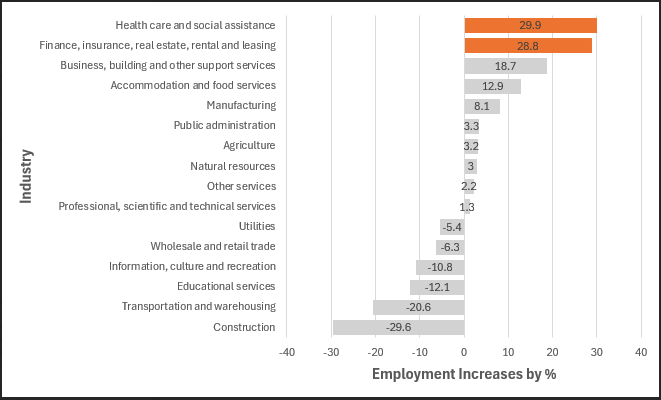In the ever-evolving landscape of Canada's job market, a closer look reveals a mosaic of opportunities and challenges. Despite some overarching concerns, certain sectors and demographics are experiencing notable growth, creating a dynamic environment for both job seekers and employers. Let's explore the emerging opportunities, demographic shifts, and regional employment patterns, as well as how the workforce is adapting to the future of work in Canada.
Emerging Opportunities in Key Sectors
The Canadian job market is currently witnessing significant growth in several key sectors. Health care and social assistance, finance, insurance, real estate, rental and leasing, business, building, and other support services, as well as accommodation and food services, are leading the way in employment growth. These sectors have shown resilience and adaptability, contributing positively to the economy and offering new opportunities for employment. The increase in jobs within these industries suggests a shifting focus towards services that cater to the growing needs of Canada's diverse population, as well as the strengthening of the country's financial and real estate markets.
Below are the HOT Verticals:


Demographic Shifts and (UN)Employment Trends
The dynamics of Canada's workforce are changing, reflecting broader demographic shifts and evolving employment trends. Notably, young women aged 15 to 24 and women aged 55 and older have seen an uptick in employment, highlighting the diversification of the workforce. However, core-aged women (aged 25 to 54) and young men have faced challenges, underscoring the need for targeted support and policies to ensure inclusive growth. Furthermore, the rise in part-time employment, including involuntary part-time work, points towards a changing landscape where work arrangements are increasingly flexible but also highlight areas of underemployment that require attention.
...and where the POOLS of Talent are:


Employment Patterns Across Canada
............Provinces the jobs are in:
Regional disparities in employment trends provide a nuanced view of Canada's job market. Ontario, Manitoba, and Saskatchewan have experienced employment growth, showcasing the economic vitality in these provinces. Conversely, Alberta, Newfoundland and Labrador, and Prince Edward Island have seen declines, illustrating the impact of various economic factors on regional job markets. These patterns underscore the importance of understanding local economic conditions and the need for region-specific strategies to foster employment growth and stability.
Adapting to the Future of Work
As Canada navigates through changing economic waters, the future of work remains a central theme. The shift towards more flexible work arrangements, including remote and hybrid models, reflects a broader transformation in how and where work is conducted. This transition, accelerated by the pandemic, presents both challenges and opportunities for workers and employers alike. Embracing technology, fostering innovation, and investing in skills development are key to adapting to this new reality, ensuring Canada's workforce remains competitive and resilient in the face of future disruptions.
In conclusion, Canada's job market is characterized by both challenges and opportunities. By focusing on sectors experiencing growth, supporting demographics facing employment hurdles, and understanding regional differences, Canada can navigate the complexities of today's job landscape. As the country moves forward, adapting to the future of work will be crucial in ensuring economic prosperity and inclusive growth for all Canadians.
..........How to GET IT DONE.
Headcount is a US and Canadian entity.
Please inquire how we can support your Canadian/US based hiring.
How we Help.
Contact us!

